A Non-Famine History of Ireland?
Published in 18th–19th - Century History, Features, Issue 2 (Summer 2002), The Famine, Volume 10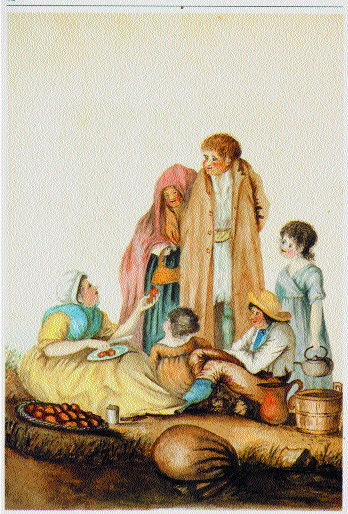
Irish beggers c.1840-note the basket of potatoes. (National Library of Ireland)
Is it possible to write famine out of Irish history? Note, the question refers to ‘famine’, not the ‘Great Famine’. The catastrophe of 1845-49 was unlike any previous famine. In the words of Peter Solar it ‘was no ordinary subsistence crisis’. Its singularity notwithstanding, Ireland’s story is often told with famine as a fugue running through a dolorous past. Yet we have concluded in our recent study of food and nutrition in Ireland, Feast and Famine, by arguing that Ireland was not a hunger-prone country, or at least not more hunger-prone than other European countries. The people of Ireland were not born to famine, although, along with their neighbours, they endured the pain of hunger whenever the harvests failed.
The European context
Until the late eighteenth century, and even into the early nineteenth, the history of Western Europe was punctuated by subsistence crises that sometimes erupted into full-scale hunger. From the great famine that ravaged Northern Europe in the early fourteenth century to ‘the last great subsistence crisis in the western world’ in 1816-17, the poor in Europe endured famished years during which some people starved to death, and many more died from the infections and deficiency diseases. Most famines were caused by failures of the grain crops brought on by bad weather. Shortages were exacerbated by an uneven distribution of food with some people enjoying plenty while others starved. Ireland shared the sufferings of Western Europe, to a greater or lesser extent. At the turn of the sixteenth and seventeenth centuries and again in the 1650s, the devastations of war added to the anguish. But Ireland was not unique in this respect. Armies in Europe could be just as devastating. Germany lost possibly 40 per cent of its population during the Thirty Years War, most of it to hunger and disease.
We entitled our book Feast and Famine to emphasise the point that there were many famine-free years and that in the years between famines there was enough food in Ireland to satisfy everybody. The word ‘feast’ is meant to convey the idea of a plenitude, even of an abundance. This is not a notion that fits comfortably into the conventional story. Yet for much of her history, people in Ireland had plenty to eat. The rich ate more lavishly than the poor, but so did they everywhere. Over-indulgence was not a sin peculiar to the Irish upper classes.
Growth of Irish food production
Ireland is naturally endowed to be a pastoral society. Before extensive settlement from England and Scotland in the later sixteenth century the diet of the people contained plenty of meat, butter and milk. But as English military commanders understood all too well, grain was an important component of winter food supplies. As colonisation progressed the boundaries of cultivation were pushed further outwards. The growth of total food production cannot be measured directly, but it was expanding sufficiently to support a burgeoning export trade and feed the growing population at home. Through the seventeenth and early eighteenth centuries food exports consisted mainly of barrelled beef, pork and butter, but after 1750 Ireland became also a major exporter of grain. There is no evidence that consumers in Ireland went chronically hungry to meet the demands of overseas markets. As long as the harvests did not fail or the livestock succumb to fatal disease, there was plenty of food available to all those who had legal access to it, an important proviso to which we will return.
The potato
From the mid-eighteenth century potatoes became important in diets. They had been cultivated in Ulster since the early seventeenth century and by the end of the century they were commonplace in the gardens of the peasantry: ‘their dearly beloved potatoes’ in the words of John Dunton. In the next century potatoes were incorporated into agricultural rotations, as a clearing crop on ground newly dug for the cultivation of corn. Potatoes enabled the margins of cultivation to be pushed further and further into the mild, damp West. Cultivators turned the virgin soil with spades and dug in dung scraped from byres and farmyards. Then they planted potatoes in the so-called lazy beds. After the potatoes were lifted the land was ready for a crop of corn. Land, labour and capital were thus brought together in an economical fashion. Crucially, potatoes added to the food supply. They fed humans and pigs alike. For a hundred years the population of Ireland grew more rapidly than elsewhere in Western Europe, sustained by a plant that was abundant and nourishing.
Abundance and nutritiousness are the essential characteristics of potatoes, to which we should add cheapness and convenience. Potatoes were easy to cook and to eat: a turf fire, a cooking pot, and fingers were all that were required. As long as potatoes flourished they banished famine from the land. Within the context of Irish history potatoes have been cast in the role of the great saviour, the crop that kept the Malthusian spectre at bay. Alternatively, potatoes have been seen as the curse of Ireland, inflicted on the native population by an iniquitous landed system.
A nutritious (but monotonous) diet
Potatoes contain good quality protein (unusual for a vegetable) and, if eaten in sufficient quantities, provide enough energy and vitamin C to sustain good health. Potatoes and milk together constitute a nutritious diet, albeit a rather monotonous one. Potatoes yielded abundantly: six tons or more per acre in a normal year in the eighteenth century. This was enough to keep a labourer, his wife and children—and his pig—well fed for much of the year. Only the ‘meal months’ during the summer, before the new crop was ready, were a problem, but then oatmeal and herrings were generally at hand to fill the gap.
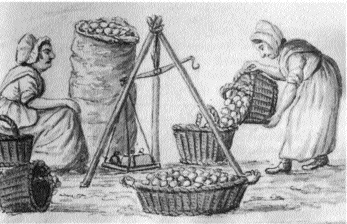
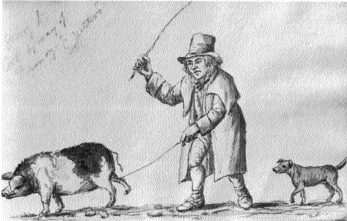
Sketches of peasant life in Youghal, County Cork, 1831, by Sampson Twogood Roch. Potatoes fed huma
People ate potatoes for pleasure. ‘Mark the Irishman’s potato bowl placed on the floor’, wrote Arthur Young, ‘the whole family on their hams around it, devouring a quantity almost incredible, the beggar seating himself to it with a hearty welcome, the pig taking his share as readily as the wife, the cocks, hens, turkies, geese, the cur, the cat, and perhaps the cow—and all partaking out of the same dish. No man can often have been a witness of it without being convinced of the plenty, and I will add the cheerfulness that attends it.’ Not only the poor cottage dwellers, but also well-bred ladies enjoyed potatoes. In 1775 they formed ‘a standing dish at every meal; these are eaten by way of bread, even by the ladies indelicately placing them on the table-cloth, on the side of the plate, after peeling them. By the 1820s ‘a partiality [for potatoes] is entertained by every intermediate rank to the palace, no table being without them’.
But it was poverty more than pleasure that pushed one third of the population onto potatoes to the exclusion of almost everything else by the beginning of the nineteenth century. A combination of the agrarian structures and economic circumstances created this precarious dependence. Most land in the eighteenth century was owned by landlords who farmed it out to subordinate landlords (the middlemen of popular infamy) or to tenant farmers. They, in turn, sub-let land to cottier-labourers. As the population multiplied, tens of thousands of very small holdings were created. From about 1750 much of the land was used to grow wheat, oats, and barley, a good deal of which was exported. But labourers and small landholders—the groups were virtually indistinguishable—tilled tiny plots to grow potatoes. The potato patches provided cheap food that served as the economic base for marriage. By the end of the eighteenth century marriage was the almost universal condition for Irish men and women. They did not marry particularly young—normally in their early twenties—but that so many young men and women entered the matrimonial state contributed to a high level of general fertility. Potatoes kept husbands and wives and their children healthy. More speculatively, mashed potatoes and milk made a convenient weaning food, enabling babies to be taken from the breast at an early age. Thus young mothers lost the contraceptive benefits of extended lactation; and so marital fertility as well as general fertility was high in the century before the Great Famine.
Potatoes and people: a fertile alliance
Potatoes and people formed a fertile alliance. The toil of the cottiers prepared the lazy beds and planted the potatoes. Potatoes fed them and kept them healthy and breeding. What benefit did the farmers derive from sub-division? They gained a supply of cheap labour which raised the crops that fed the better off and made Ireland an important exporter of food.
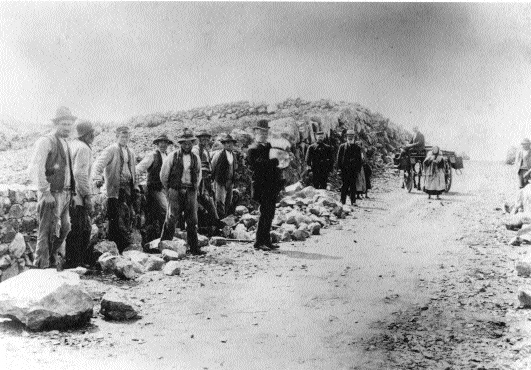
Relief works, Inverin Hill, County Galway, c.1890-during the Famine the money earned from such schemes was not enough. (Sean Sexton)
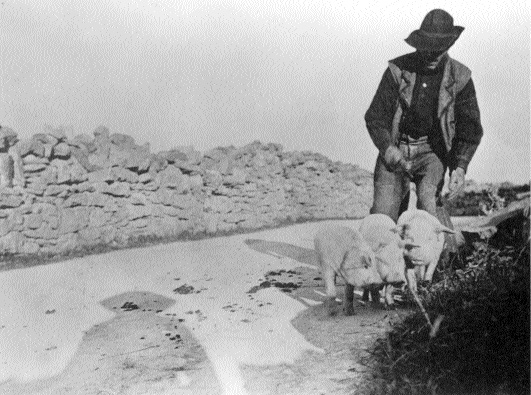
Pigs were potatoes capitalised: they were fattened on potatoes and sold for the money needed to pay the rent and the few articles of clothing and furniture essential for life. (Sean Sexton)
By the beginning of the nineteenth century men labouring in the fields consumed ten to fourteen pounds of potatoes a day, washed down with milk or buttermilk. Their wives and children ate less in proportion and the family pig demolished a similar amount. Pigs were potatoes capitalised: they were fattened on potatoes and sold for the money needed to pay the rent and the few articles of clothing and furniture essential for life. But how was it that the poor came to rely so much on a single source of food? Part of the answer is that potatoes were cheap, plentiful, nourishing, and convenient. Everything else was sent to market. As Robert Bell explained in 1804: ‘[the peasantry] lived on those things for which little or no money could be procured at market: potatoes constituted their chief food. The next article he retained for his own use was one of still less value, it was that part of the milk which remained behind after butter had been extracted from it.’
Potatoes entered diets too late for their failure to play a significant part in famines before the mid-eighteenth century. During the famine of 1727-8 potatoes eased the blow of the failure of the grain harvests. In the severe famine of 1740-41 the cereal harvests were poor and the potato crop was ruined by the great frost in the winter of 1739-40. By now a significant proportion of the population relied on potatoes for their winter food and their loss created severe hardship. As many as 480,000 people may have starved to death or died of famine-related diseases in 1740 and 1741, a mortality rate (if accurate) proportionately greater than during the Great Famine.
Nothing so terrible occurred again for a hundred years. There were periodic shortages of food as the grain or potato harvests failed as the result of cold or wet. The years 1783-4 were especially bad, but the hardships of the second half of the eighteenth century were localised and short-lived. At the end of the century bad weather, harvest failures, and wartime inflation made 1799 and 1800 very difficult for the poor. In 1816-7 famine deaths may have reached 80,000. Harvests were poor throughout Europe as dust from volcanic eruptions in the East Indies blotted out the sun and resulted in two cold years. Ireland, though, was less badly affected than continental Europe. Further localised food shortages occurred in 1822 and in the early 1830s, but it is only with a very large dose of hindsight that these episodes can be interpreted as ineluctable steps to the Great Famine.
Phytophthora infestans
During the Great Famine the potato crops failed from an unknown cause. Previous failures of cereals and potato were the result of bad weather. Occasionally the growth of potatoes was curtailed by drought. Leaf curl and rot depressed yields in one or two years. Nothing, though, portended the arrival of phytophthora infestans. The disease had first been seen in North America in 1843 and was spotted in Belgium in June 1845. Its arrival in Ireland was famously announced in the Gardeners’ Chronicle in September 1845. One or two observers identified the blight as a fungal infestation, but government officials, scientists, landlords, and cultivators alike were united in not knowing how to deal with it.
Phytophthora infestans was an omnivorous destroyer of potatoes. A third of the harvest was lost in the first year (1845), 75 per cent in the second year, and 37 per cent in the fourth year. Yields in the third year (‘Black ‘47’) were normal, but little had been planted. Losses of this extent and sustained over four years were, as Peter Solar has pointed out, way beyond anything that could be predicted based on European experience. The intensity of the failures was magnified because three million people relied on potatoes for their survival. Potatoes rotted elsewhere in the United Kingdom and in Europe in 1845-9, but it was only in Ireland that they were almost the sole support of so many people. Their loss left people starving and vulnerable to deficiency diseases, and infections such as typhus, relapsing fever, diarrhoea and dysentery. Infections themselves are not the direct consequence of chronic hunger, but malnutrition lowers peoples’ resistance to infections; and the towns and feeding stations into which the starving people crowded, were havens for infectious diseases of all kinds.
The death of 12 per cent of the population between 1845 and 1851 as a result of famine did not quite reach the proportion suffered in 1740-41, but the absolute number—more than one million dead—was beyond past experience. It was all the more shocking because it happened so late into the nineteenth century.

Blight-affected potatoes preserved for posterity. (Bord Fáilte)
To the deaths of the born we must add the unborn, that is births that might have occurred had the Famine not killed the potential parents. These averted births could have totalled 400,000. Another one million people fled Ireland. In a few short years Ireland lost two million men, women, and children.
What could have been done?
What could have been done to avert such a tragedy? This question more than any other has dominated considerations of the Great Famine and the answers have done much to force famine to the forefront of Irish history. Over the course of the Great Famine the supply of calories declined by almost a quarter. At the same time there was a reduction in the amount of grain (mainly oats) exported. There was also a fall in the quantities of cereals and potatoes used for brewing and distilling and fewer potatoes went to feed pigs. Indian corn was imported from America to offset the loss of the potatoes. But the fact remains that the blight deprived the poor of their basic food. Solar has argued that the loss of potatoes between 1845 and 1849 was so great that the gap was too large to be plugged.
The fungus did not attack wheat, barley or oats, although poor weather and a shortage of labour depressed their output. Nor was the production of meat (apart from pork and bacon) and butter seriously disrupted. Many people have argued, therefore, that there was enough food available to feed the hungry and prevent starvation. The loss of potatoes might not have been entirely compensated for by giving the poor access to the corn, meat, butter, and beer that were exported. But the diversion of exports to domestic consumption might have saved many lives.
This diversion, though, was not a simple matter. Individuals—farmers and merchants—owned the exports and they were engaged in normal market trading. Presumably they would have sold their grain, meat and butter in Ireland had it been profitable to do so. But the poor did not have the money to buy the food. In the language of Amartya Sen, they lacked ‘entitlements’ because they did not own it and could not afford to purchase it. The alternatives were that somebody else—benevolent landlords, the clergy, or the government, perhaps—should buy it for them, or that the poor should be provided with work so that they could earn the money.
Some landlords did spend money feeding the poor, Catholic priests and Protestant clergy did what they could, but many landlords were not in a position to help or were unwilling to do so. For the government the issue was one of cost and attitudes. The money would have to come from the Treasury or from local rates. The will was lacking in Westminster to sanction massive spending and Irish ratepayers were reluctant to pay higher taxes. In all the government spent £9.5 million on famine relief, including the soup kitchens that functioned through the spring and early summer of 1847. This was a measly amount in face of a huge disaster.
Work aid was tried in 1846 and 1847, but the schemes were widely criticised for their inefficiency. In any case the money earned was not enough. In March 1847 the journalist Alexander Somerville came across a man earning ten old pence a day. He met his wife and children, ‘skeletons all of them, with skin on the bones and life within the skin’.
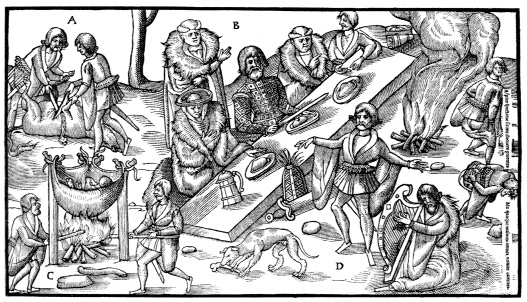
‘Irish Lord feasting: the Feast of the MacSwynes’ from John Derricke’s The Image of Irelande (1581)-for much of her history, people in Ireland had plenty to eat.
The earnings were simply too little to make any difference. From the autumn of 1847 poor relief was left to the inadequate workhouses or to private charity. The government in Westminster had a touching faith in the market. To interfere with private property was anathema. Therefore relief food had to be purchased or, if distributed freely, it should go only to those people deemed to be deserving of it. However, market mechanisms were ill-suited to cure Ireland’s problems. The potato eaters were poorly integrated into the market. They were frequently paid, not in money, but by the use of land on which to grow potatoes. For many of them their source of cash was the pig; but the pig too was a casualty of the Famine. If they were able to find paid employment their wages were not enough to pay for the food they and their families needed. The market-based ideas of political economy prevalent in mid-nineteenth century Britain could not save the starving people of Ireland.
Conclusion
The Great Famine was a unique event that has dominated Irish historiography. It has produced a teleological view in which everything that came before leads to the crisis. But we should avoid the conclusion that Irishmen, women and children in the past lived in a state of chronic under-nourishment, which not infrequently turned into full-scale starvation. In the sixteenth and seventeenth centuries there was meat aplenty: ‘As for the greatest Karne, thei have the cheefest stuffe: Though dirtie tripes and offals like please under knaues enough.’ So wrote John Derricke in 1581. In the early seventeenth century, according to Fynes Moryson, the ‘mere Irish’ drank milk straight from the cow, ate lumps of butter but no flesh except ‘that which dies of disease or otherwise of itself, feed mostly on white meats [i.e. dairy produce], and esteem for a great dainty sour curds, vulgarly called by them Bonnaclabbe’. Sir William Petty reported in 1672 that during winter, the Irish ate ‘Bread in cakes’. In the summer, if they lived near the sea, people had shellfish harvested from the shoreline. For everybody there was the occasional hen or rabbit, all washed down with ‘milk, sweet and sower, thick and thin’. They ate ‘potatoes from August to May’. Potatoes became increasingly important as a winter food and by the end of the eighteenth century constituted the main food of the poor. They were tasty, cheap, abundant, nourishing, and convenient. For the poor they were a boon. They were too bulky in relation to value to be traded extensively, and they could not be stored from year to year. The danger of potatoes, though, lay less in themselves than in the dominant position they assumed in diets. If the harvests failed, as they did in 1845, 1846, and 1848, then the potato eaters were left precariously exposed.
It is possible to write a non-famine history of Ireland, but the story of Ireland with the Great Famine left out would make no sense.
L. A. Clarkson is Emeritus Professor of Social History, Queen’s University, Belfast. E. Margaret Crawford is Senior Research Fellow, Centre for Social Research, Queen’s University, Belfast.
Further reading:
L.A. Clarkson & E.M. Crawford, Feast and Famine: Food and Nutrition in Ireland 1500-1920 (Oxford 2001).
E.M. Crawford (ed.), Famine: the Irish Experience 900-1900 (Edinburgh 1989).
A. Bourke, ‘The Visitation of God’? The Potato and the Great Irish Famine (Dublin 1993).
C. Ó Gráda, Black ‘47 and Beyond: the Great Irish Famine in History, Economy, and Memory (Princeton 1999).
















